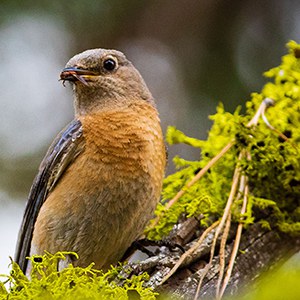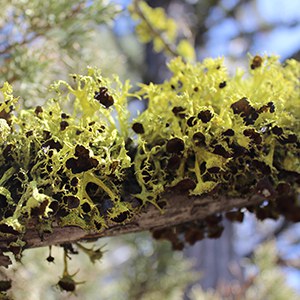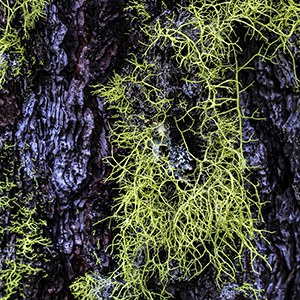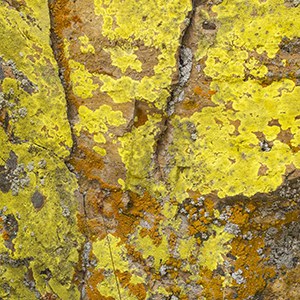Have you taken a liking to lichen? With a variety of greens, oranges, golds, scarlets, and many colors in between, lichens are a beautiful part of our natural world. With thousands of different lichens in North America (that we know about!), these oft misunderstood parts of nature play a vital role in our environment.
What are lichens?!?
Lichens are actually a symbiotic partnership of two separate organisms—a fungus and an alga. The fungus provides structure to the lichen and prevents the alga from drying out, while the alga is able to photosynthesize and make food. The dominant partner is the fungus, which gives lichen a majority of its characteristics. The alga that is part of lichen can be either green alga or blue-green alga (also known as cyanobacteria). Many lichens even have both types of algae!
Fungi have their own kingdom that is separate from plants. They do not contain chlorophyll or have any other means of producing their own food, so they rely on other organisms for this. Meanwhile, Algae are in the Protista kingdom, which is separate from plants and fungi. Algae can survive in salt water and freshwater on their own, but as part of a lichen partnership, they are able to survive in many additional types of environments! Not to get too confusing, but while cyanobacteria are called blue-green algae, they are actually bacteria.
Depending on the lichen, it can grow on rocks, trees, soils, and even other lichens. They can be found in the arctic, on mountain summits, in the desert, and in the tropics. They are very diverse, highly adaptable, and are an ancient form of life. In Central Oregon, you’ll see lots of types of them on the rocks and trees in our high desert and our mountain forests. When you see lichens growing on trees, please note that they are not hurting the trees or taking nutrients from the trees.
Often, lichens are confused with mosses. However, unlike mosses, lichens have no roots, stems, or leaves. They are similar in size and habitat, and can often be found growing near one another though.
Lichens have many benefits. They are a food source for deer, squirrels, small rodents, bats, and elk, to name just a few animals. In addition, many small insects live in lichens, which provides food for birds.
Since some lichens have a partnership with cyanobacteria, these types of lichen are able to take nitrogen out of the air and fix it (thanks to the cyanobacteria). Lichens can also help build healthy soil as well as convert carbon dioxide in the atmosphere into oxygen through photosynthesis.
Since lichens pull nutrients out of the air, they also absorb pollutants from the air. This natural process helps researchers and scientists understand if an area has air pollution by monitoring the pollutants in the area's lichens. This form of monitoring, also known as lichen biomonitoring, helps “detect, map, evaluate trends, and assess ecological impacts of air pollutants,” according to the US Forest Service’s National Lichens and Air Quality Database and Clearinghouse.
In certain indigenous cultures, lichens have been used for food, bedding, medicine, and even canoe sealant. Today, lichens can be found in deodorant, toothpaste, salves, and perfumes.
Threats to lichens
Lichens are threatened mainly by loss of habitat. Some of this is caused by development. In addition, climate change is altering the environment and causing habitat loss for lichens as well. Many types of lichens are sensitive to air pollution, which can also cause lichen loss. Since there are many types of lichen in the soils around Central Oregon, these can be threatened by grazing.
Does a gray lichen mean a dead lichen?
Often, you’ll see lichen that is gray. Does that mean it’s dead? Nope! Most gray lichens will turn green or dark blue-green when they receive moisture. And some gray lichens will always look gray, regardless of whether they’re wet or not. Most lichens will appear bleached looking once they die.
A few common lichens in Central Oregon
Here’s a guide to just a few of the common lichens in Central Oregon. Try to spot these the next time you’re out on a walk or cross country ski!
This lichen is also sometimes referred to as wolf lichen, American wolf lichen, Western wolf lichen, or brown-eyed wolf lichen. The brown-eyed wolf lichen name comes from the brown discs, known as apothecia, that resemble eyes. Letharia columbiana is about 1-4.5 inches tall with loosely branching, intricately irregular branches. These branches are uneven thickness. Letharia columbiana is an almost fluorescent yellow green to chartreuse color. This lichen is quite common in Central Oregon and can often be found on juniper and ponderosa pine trees (and sometimes even on branches that have snapped off and are on the ground!). You’ll want to keep an eye out for them on the junipers at Whychus Canyon Preserve.
Also known as wolf lichen, this lichen can be found in western North America and western Eurasia. It is incredibly common in Central Oregon and can be found at such varied areas as the Metolius Preserve and Whychus Canyon Preserve. They are usually found on bark or wood, especially on conifers. Similar to Letharia columbiana (seen above), note that this lichen doesn’t have brown apothecia. It can grow 1-2 inches tall and often appears almost beard-like with entangled branches that are irregular and often forked. Letharia vulpina is lemon yellow, golden yellow-green, chartreuse, or fluorescent yellow green.
Sometimes referred to as golden cobblestone lichen, it is very common on steep rock walls throughout North America and Europe, including on rocky outcroppings and underneath overhangs. It forms large circular areas with lobes on the edges of the circles. Pleopsidium flavum has a rough texture. It is a vibrant, bright yellow or green-yellow. You can often spot this lichen out in our high desert landscape.
The next time you’re outdoors, see how many different types of lichens you can spot! With your newfound knowledge in tow, you might discover there’s a lot more to see than you ever imagined previously.
Learn more:
- Five Fun Facts about Lichen
- Common Macrolichens of the Pacific Northwest
- U.S. Forest Service National Lichens & Air Quality Database and Clearinghouse
Sources:
- A big thank you to OSU professor Bruce McCune for his assistance with this blog post!
- Consortium of North American Lichen Herbaria
- U.S. Forest Service
- ASU Biodiversity Knowledge Integration Center


